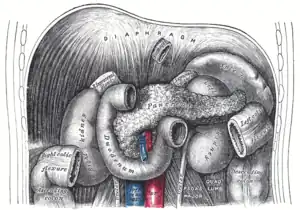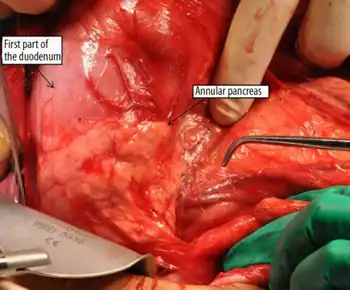Annular pancreas
| Annular pancreas | |
|---|---|
 | |
| Duodenum and pancreas (normal anatomy) | |
Annular pancreas is a rare condition in which the second part of the duodenum is surrounded by a ring of pancreatic tissue continuous with the head of the pancreas. This portion of the pancreas can constrict the duodenum and block or impair the flow of food to the rest of the intestines. It is estimated to occur in 1 out of 12,000 to 15,000 newborns.[1] The ambiguity arises from the fact that not all cases are symptomatic.[2]
Signs and symptoms
Early signs of abnormality include polyhydramnios (an excess of amniotic fluid), low birth weight, and feeding intolerance immediately after birth, in particular a tendency to develop epigastric distention associated with non-biliary vomiting (the obstruction is generally above the papilla of Vater, therefore superior to the junction with the bile ducts). Different chromosomal diseases (for example trisomy 21 and, with a minor frequency, trisomy 18 and trisomy 13) are present in about 33% of subjects affected by annular pancreas.[3][4] In adults, the clinical picture is often dominated by the sensation of postprandial distension, abdominal pain in the epigastric region, nausea and vomiting that may be present for a long time (sometimes for years) before reaching a precise diagnosis.
Causes
It is typically associated with abnormal embryological development, however adult cases can develop. It can result from growth of a bifid ventral pancreatic bud around the duodenum, where the parts of the bifid ventral bud fuse with the dorsal bud, forming a pancreatic ring. It can also result if the ventral pancreatic bud fails to fully rotate, so it remains on the right or if the dorsal bud rotates in the wrong direction, such that the duodenum is surrounded by pancreatic tissue. Blockage of the duodenum develops if inflammation (pancreatitis) develops in the annular pancreas.
Diagnosis
Postnatal diagnostic procedures include abdominal x-ray and ultrasound, CT scan, and upper GI and small bowel series. Abdominal radiography can show the classic sign of the "double bubble": the presence of air in the stomach and duodenum.[5][6] Unfortunately, this double-bubble sign is not pathognomonic for annular pancreas, as it can also be observed in other conditions, such as duodenal atresia[7] and intestinal malrotation.[8] Upper GI series may be suggestive of annular pancreas, especially if they show a duodenal narrowing of the second portion of the duodenum and the concomitant dilatation of the proximal duodenum. In some cases it is possible to have signs of inverse peristalsis of the duodenal tract which is proximal to the narrowing caused by the annular pancreas, and the dilatation of the duodenal portion distal to the anomaly. An abdominal CT scan or an MRI allows to highlight the narrowing of the descending duodenal tract and the ring of pancreatic tissue surrounding the duodenum: this ring can be complete or, in patients with an incomplete annular pancreas, extended in a postero-lateral or anterolateral direction with respect to the second part of the duodenum. ERCP or MRCP with secretin allow precise delineation of the anatomical structure and in particular a good visualization of pancreatic ducts, as well as a careful analysis of pancreatic secretion into the duodenum lumen.[9]
Treatment

In neonates, treatment for relief of obstruction usually is bypassing the obstructed segment of duodenum by duodeno-jejunostomy.[10]
In adults, due to the minor duodenal mobility, the approach is laparoscopic gastrojejunostomy or duodenojejunostomy.[11][12]
References
- ↑ Lainakis N; Antypas S; Panagidis A; et al. (2005), "Annular pancreas in two consecutive siblings: an extremely rare case", European Journal of Pediatric Surgery, 15 (5): 364–8, doi:10.1055/s-2005-865838, PMID 16254852
- ↑ Ravitch, MM. (1975). "The pancreas in infants and children". Surg Clin North Am. 55 (2): 377–85. doi:10.1016/S0039-6109(16)40587-6. PMID 165579.
- ↑ Sencan A, Mir E, Günsar C, Akcora B (June 2002). "Symptomatic annular pancreas in newborns". Med. Sci. Monit. 8 (6): CR434–7. PMID 12070435. Archived from the original on 2018-03-13. Retrieved 2018-03-12.
- ↑ Yigiter M, Yildiz A, Firinci B, Yalcin O, Oral A, Salman AB (December 2010). "Annular pancreas in children: a decade of experience". Eurasian J Med. 42 (3): 116–9. doi:10.5152/eajm.2010.33. PMC 4261261. PMID 25610139.
- ↑ Dankovcik R, Jirasek JE, Kucera E, Feyereisl J, Radonak J, Dudas M (2008). "Prenatal diagnosis of annular pancreas: reliability of the double bubble sign with periduodenal hyperechogenic band". Fetal Diagn. Ther. 24 (4): 483–90. doi:10.1159/000178759. PMC 2814148. PMID 19047797.
- ↑ Raman VS, Arora M, Khanna SK (2015). "Annular pancreas, type I choledochal cyst and malrotation in a low-birth weight newborn: A case report". J Indian Assoc Pediatr Surg. 20 (3): 155–6. doi:10.4103/0971-9261.154656. PMC 4481632. PMID 26166991.
- ↑ Poki HO, Holland AJ, Pitkin J (June 2005). "Double bubble, double trouble". Pediatr. Surg. Int. 21 (6): 428–31. doi:10.1007/s00383-005-1448-z. PMID 15912365. S2CID 21589667.
- ↑ Imamoglu M, Cay A, Sarihan H, Sen Y (April 2004). "Rare clinical presentation mode of intestinal malrotation after neonatal period: Malabsorption-like symptoms due to chronic midgut volvulus". Pediatr Int. 46 (2): 167–70. doi:10.1046/j.1442-200x.2004.01859.x. PMID 15056243.
- ↑ Cholet F, Bideau K, Nonent M, Nousbaum JB, Gouérou H, Robaszkiewicz M (2004). "Coexistence of annular pancreas with carcinoma in the dorsal part of pancreas divisum: diagnostic value of magnetic resonance cholangiopancreatography". Abdom Imaging. 29 (6): 703–6. doi:10.1007/s00261-004-0178-3. PMID 15185031. S2CID 19701907.
- ↑ Pansini M, Magerkurth O, Haecker FM, Sesia SB (September 2012). "Annular pancreas associated with duodenal obstruction". BMJ Case Rep. 2012: bcr2012006855. doi:10.1136/bcr-2012-006855. PMC 4544741. PMID 22987909.
- ↑ De Ugarte DA, Dutson EP, Hiyama DT (2006). "Annular pancreas in the adult: management with laparoscopic gastrojejunostomy". The American Surgeon. 72 (1): 71–3. PMID 16494188.
- ↑ Cheng L, Tian F, Zhao T, Pang Y, Luo Z, Ren J (October 2013). "Annular pancreas concurrent with pancreaticobiliary maljunction presented with symptoms until adult age: case report with comparative data on pediatric cases". BMC Gastroenterol. 13: 153. doi:10.1186/1471-230X-13-153. PMC 4015270. PMID 24156788.
External links
| Classification | |
|---|---|
| External resources |